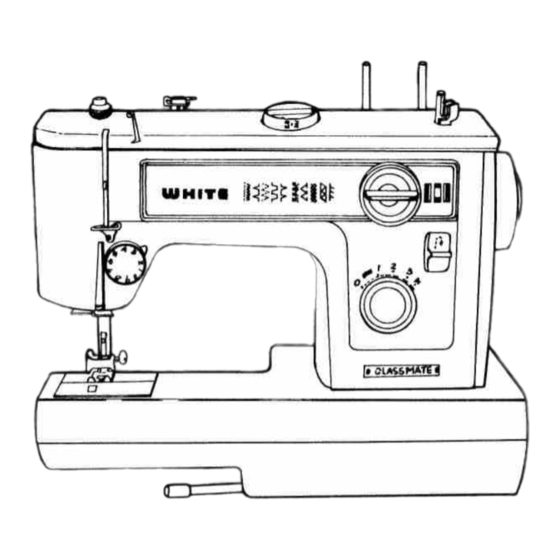
Subscribe to Our Youtube Channel
Summary of Contents for White CLASSMATE 1570
-
Page 2: Sewing Machi Ne
_______________________ You are now the owner of a new zig zag sewing machine , the most versatile type of its kind you can possess, Buttonh oles, monogra mming, overcast ing and creative embroid ery are done with ease and speed. To aid you in obtainin g the greatest performa nce from your new sewing machine , this book on its care and use has been written for you. - Page 7 gwlng to straigh t sewing .
- Page 8 -—...
- Page 10 —...
- Page 17 CONTR OLS TOP TENSION CONTROL Probably the most important control on your machine is this one that It consists of discs between which regulates your top thread tension. the thread passes. The pressure on these discs is regulated by turning control.
- Page 22 — —— — ——...
- Page 26 Starting to Sew Now that you are familiar with the controls on your machine and with the accessories provided for the machine, you are ready to start to sew. Below are some good habits to follow each time you sitdown to sew: 1.
- Page 30 is a /‘VV/ Pattern: Lenght: 0 Width: Utility stitch upward Special stitch Pressure : Normal Foot: Button Foot...
-
Page 31: Satin Stitch Ing
SATIN STITCH ING This is useful for decorati on such as tapering , manual designe d embroid ei y, monogr amming , and appliqu e. The satin stitch, which is a very close zigzag stitch, is obtained by setting the stitch length as near toO” as possible without stopping the feeding action setting will vary for differen t fabrics. - Page 33 ,,‘ ‘ A A-A”! A...
- Page 35 /V’.
- Page 38 ..1Lj\_.
- Page 40 Pattern: Any Length: >t.5 Width: O2 Foot: All Purpose...
- Page 43 — —...
-
Page 46: Stretch Buttonholes
STRETCH BUTTONHOLES Step 1 This buttonhole is used on knit fabrics when it Step 2 is desirable to omit interfacing or cording. — — This buttonhole will stretch and return to shape unlike an ordinary zigzag buttonhole. pattern of the stitch makes the buttonholes nearly invisible when using mat It is excellent to use on jerseys, ching thread. - Page 50 APPLICATIONS DOUBLE OVERLOCK STITCH SEAMING DOUBLE OVERLOCK STITCH This stitch gives a finished 1/4 inch seam in one step. knits, gives strength and elasticity curling seams prevents of the fabric that occurs with inch opened often seams. It is most applicable to soft, thin knits such as nylon or acetate knits, but may be used fabrics well.
- Page 51 TOPSTI TCHING DOUBLE OVERL OCK — The double overlock stitch can be used to topstitch — — — — nonravel ing fabrics such as felt or leather into place for applique s or pockets. Stitch so that the straight part of the stitch is formed over the edge of the leather, and only the zigzag part holds it in place.
-
Page 54: Knowing Your Sewing Machine
KNOWING YOUR SEWING MACHINE 1. Needle plate 12. Bear thread guide 2. Feed dogs 13. Stitch selector 3. Presser foot screw 14. Stitch width control 4. Seam guide lines 15. Special stitch selector 5. Thread guide 16. Reverse stitch control 6. - Page 56 Button sewing foot...
- Page 59 Use cloth guide when sewing a long seam of regular Cloth guide distance from edge of material . — Set guide in hole on arm, at right of needle plate, and adjust distance . Run machine with edge of fabric touching guide. cloth guide at an angle to sew a curved seam.
- Page 60 Zipper Sewing Foot Zipper Foot Set machine as shown. By using special zipper foot with sliding adjuster, zipper sewing can be easily done without turning fabric. and set (oot so that needle comes Loosen screw Tighten screw. into position Sew right side of zipper guiding fabric carefully so that right side teeth of zipper are parallel with left edge of foot.
- Page 62 MAt NTENANCE Your new macnine requires regular cleaning and oiling for satisfactory performance. A machine which is used for a few hours a day needs to be cleaned and oiled once a month. Unplug machine before cleaning or oiling. A. Disassemb’ing Shuttle (for cleaning) Turn hand wheel toward you to raise needle to highest position.
- Page 63 C. Oiling Apply a few drops of oil around face of hook and to center hole after oiling, wipe with a piece of cloth. D. Assembling Shuttle Reverse procedure used for disassembling shuttle. E. Changing Light Bulb Unplug machine. Open face cover bulb counterclock plate.
-
Page 65: Trouble Chart
TROUBLE CHART Trouble Probable Cause Correct Operation See Page 7-9-12-59 Not plugged in properly. Machine does Power supply switch is not on. not sew Thread is stuck in the hook groove. Spindle is pushed to the right. Bobbin winder Making noise Lack of oil. - Page 66 See Page 9-10-15 Improper upper threading. Not using a ball point needle for elastic and thin fabric. Improper tension. Sewing foot not suitable for the work. See Page 10 Stitches not Upper thread tension too loose. locked Improper tension of lower thread. Improper needle for thread.









Need help?
Do you have a question about the CLASSMATE 1570 and is the answer not in the manual?
Questions and answers